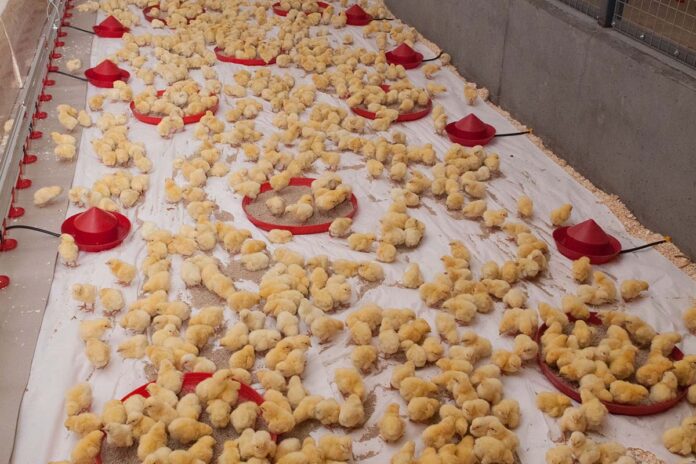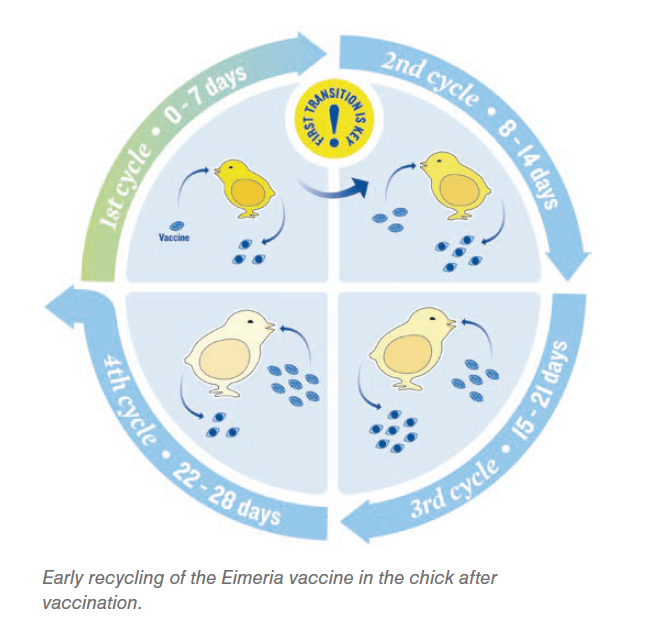
Coccidiosis is a disease of the intestinal lining, produced by the invasion of the mucosal cells by a very prolific protozoan parasite of the genus Eimeria.
This invasion results in the interruption of feeding and digestive processes involved in nutrient absorption. Coccidiosis control with the use of vaccines is achievable. The proper application and management of coccidiosis vaccines will protect against coccidiosis outbreaks and avoid concerns with performance, bird welfare and financial losses.
Clinical coccidiosis in breeders can be prevented by using anticoccidials in the feed (ionophores and non-ionophore anticoccidials [NIA]). Today, however, more than 70% of breeder flocks globally are vaccinated at the hatchery. Coccidiosis vaccines are commonly used if they are available. The successful use of coccidiosis vaccines involves:
- Proper handling, storing and administering the vaccine
- Effective brooding practices
- Successful vaccine cycling or recycling
Vaccine handling, storage and administration
Most vaccines are based on suspensions of live (viable) sporulated oocysts. They vary in the content of coccidia species, the number of oocysts, and strain pathogenicity. Coccidiosis vaccines can be originated from attenuated and non-attenuated strains.
The best place for coccidiosis vaccination is at the hatchery, where conditions are ideal for mass application, and there is usually better control over vaccination preparation and mixing.
When using a coccidiosis vaccine:
- Never freeze coccidiosis vaccines because they contain live oocysts.
- Follow the manufacturer’s instructions for mixing the vaccine with a diluent.
- Ensure a uniform distribution of the vaccine via spray cabinet mist or gel droplets and ensure equal exposure of all chicks to live oocysts (use a dye if necessary).
- Provide birds with enough time and light intensity after vaccination in the hatchery to allow for preening.
- Keep chicks comfortable in terms of temperature and relative humidity after vaccination.
- Allow chicks to dry and avoid exposing them to high airspeeds or drafts.
There may be situations where coccidiosis vaccine application on the farm should be considered as either the only vaccine applied or as a revaccination. Vaccination on the farm can occur when vaccines cannot be administered at the hatchery or as a choice made by the customer for a better “take” on a particular species. On the farm, revaccination has been used to ensure adequate/uniform vaccine coverage and early oocyst cycling.
There are different commercially available vaccines for use in breeders. Most commercial vaccines available for breeder pullets include E. acervulina, E. tenella, E. necatrix, E. maxima, E. mitis, and E. praecox, or a combination of selected species.
Brooding practices
When using a coccidiosis vaccine, achieving early and uniform immunity (within the first 3-4 weeks of a chick’s life) is essential for ensuring long-lasting protection. The development of immunity to coccidia requires several consecutive cycles or passes through the bird in the field. The first exposure to the coccidia parasite occurs during vaccination, and the rest of the cycling process continues on the farm. Each cycle requires the ingestion of sporulated oocysts by the bird. The parasite invades and multiplies within the intestinal cells several times, and the cycle ends with the shedding of the unsporulated oocysts in the feces. Then, under the right conditions (oxygen, litter temperature of 26-30 °C (79-86 °F), and litter moisture of 25-35%), the oocysts sporulate in the litter, ready to repeat the cycle. Immature oocysts shed by the bird remain dormant in the litter until specific conditions allow their sporulation.
Several situations should be carefully managed during brooding to ensure full immunity can develop:
- Managing the litter moisture and temperature requires close attention and is essential to the proper development of immunity to coccidia. Managing stocking density during the first three to four weeks is an excellent way to influence litter humidity and temperature for optimal intestinal development, coccidia sporulation and cycling. Brooding rings, brooding areas or partitions, particularly for breeders, are excellent ways to control the stocking density, feeder and drinker space.
- It is important not to release chicks too soon into areas where coccidia oocysts have not been shed, which can compromise the recycling and uniformity of the process and development of immunity.
- If covering the brooding area with paper and subsequently removing it, be sure to remove the paper before the chicks start shedding the vaccine oocysts (this usually starts five days after vaccination). Removing the paper later than day four after vaccination might reduce proper exposure to the vaccine oocysts shed by the birds and limit the cycling necessary for immunity.

Vaccine cycling/recycling
It is essential to remember that coccidia must cycle in the bird 3-4 consecutive times for full immunity to develop. The length and number of cycles depend on the Eimeria species infecting the chicken. In general, the Eimeria species cycle is between 5 and 7 days. Disruption in going from the first cycle to the second will cause some birds to start building immunity, while others remain naive to coccidia. Poor uniformity of immunity increases the risk of coccidiosis outbreaks due to high numbers of oocysts infecting a naive population of chicks. The consequences of these outbreaks are significant; treatment with anticoccidials may be required; bird welfare and performance will be adversely impacted, leading to financial losses. Always contact your veterinarian to discuss any treatment if needed.
Other conditions that disrupt uniform immunity:
- Disease challenges such as Infectious Bursal Disease (IBD), Marek’s and Chicken Anemia Virus (CAV) cause immunosuppression and result in excessive replication of the coccidia that may lead to coccidiosis breaks later in life.
- Situations that lead to immunosuppression including stress, mycotoxins, cold brooding temperature, lack of feeder space, or marginal nutrition.
- Supplements with anticoccidial properties given to chickens can impact the vaccine cycling and development of immunity.
- Excessively dry litter conditions prevent the sporulation of oocysts.
- Extremely wet litter conditions increase sporulation, which can lead to an excess of sporulated oocysts and lesions that resemble a coccidiosis outbreak.
Evaluate proper cycling in the field between 7 and 28 days with:
- Necropsy observations of chickens in the field (avoid choosing sick birds).
- Collecting feces samples for oocysts counts (per gram of feces) by laboratory analysis to evaluate if cycling/replication occurs or if a problem with vaccine application exists.
- In antibiotic-free (ABF) or No Antibiotics Ever (NAE) production programs, the use of phytogenics, botanicals or plant extracts in the feed or water might be helpful in conjunction with the coccidiosis vaccine to try and modulate the cycling of the vaccine.
In conclusion, optimal management practices during the first 3-4 weeks of age after coccidiosis vaccination are essential to complement a good vaccine application in order to provide the best conditions for the coccidia to cycle and achieve long-lasting immunity against coccidia species.

















